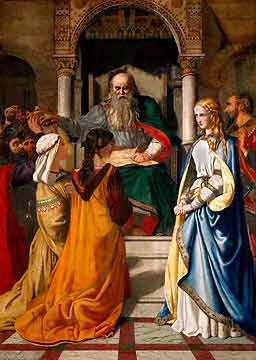Similarities
The basic plot. Both stories contain the same basic plot. Lear tests his three daughters on their individual declarations of love for him, Cordelia is sent to France, and Goneril and Regan eventually take power with their husbands.
The main characters. King Lear, along with his three daughters and their husbands, all remain relatively true to the original source. Lear is portrayed in both as the doting father with a temper, Cordelia as the innocent one, and Goneril and Regan and their husbands as the schemers and liars.
Dialogue. There are several specific scenes that are similar between the two texts. The original is much shorter, but still includes some dialogue that is very similar to Shakespeare's lines. One example is Cordelia's accounting of her love for Lear. Here is the original: "You truly have have as much of my love as you are worth: that's how much I love you." And here is Shakespeare's: "I love Your Majesty according to my bond, no more nor less." Not identical, obviously, but enough to make a connection.
Differences (there are a LOT more)
New plot lines. There is quite a bit more action and dialogue going on in Shakespeare's Lear than in Geoffrey of Monmouth's "A History." There is the whole business with Gloucester and his sons Edmund and Edgar, Kent in disguise, and the fighting over Edmund by both Goneril and Regan that was not in the original story. My reasoning for this is that Shakespeare had to add things to make the play long enough for performance, since the original text is only a few paragraphs long.
Minor characters. Shakespeare adds an assortment of new characters to the story. Kent, Gloucester, Edgar, Edmund, Oswald, the Fool, and the other secondary characters are all new additions. Why did he add so many? Like I said above, it may have been to simply add length to an otherwise short story, but I think it also may have been to give the major characters depth. For example, in the original, it doesn't elaborate much on what kind of king Lear was, or how he was as a person. In the play, by including such characters as the Fool, Kent, and Gloucester, I feel we have a glimpse of what kind of a king Lear must have been. These three men, among others, follow the king with absolute loyalty, even out into a terrible storm just to make sure he's safe. Also, even though his older two daughters despise him, we know that he must have been a decent father, since Cordelia loved and cared for him deeply.
Slight changes to the plot. Throughout the play, Shakespeare made slight adjustments to the original story. There are several examples of this. First of all, in the historical account, the king of France is not actually present during the first scene where Lear awards his lands to his daughters. He is still in France and only hearing of Cordelia's beauty is enough for the marriage to take place. He claims that "he had gold and silver and lands enough." Interesting that the only daughter to be disowned by her father is also the only one to marry for love.
Another change made was how Goneril and Regan took control. In the play, it was immediate: the power was granted to them by their father. In the source, however, it's very clear that it really happened much slower. When Cordelia is sent to France, it states that "after a long space of time, old age began to wear Lear down, and the dukes to whom he had partitioned the kingdom and married his daughters rose up against him. They seized from him the kingdom and the sovereign power that he had hitherto wielded bravely and gloriously." So in the original, the sons-in-law actually forcefully took Lear's power while Shakespeare gives a much more peaceful transition.
One more major change is obviously the ending. Since we know that it is a Shakespearean tragedy, people have to die at the end. After the battle between Lear and his two daughters, almost everyone (including Lear and his three daughter) ends up dead in a sad twist of fate. In the original version, however, the ending was much happier. Lear's and Cordelia's forces defeated those of Goneril's and Regan's, and Lear lived for three years after regaining his power. After his death, it states that "Cordelia assumed the governance of the kingdom." Much less sad, yes? I'm curious, however, why Shakespeare didn't have Cordelia end up alive and in control of the country. Coming from the time of Elizabeth, you would think he'd be open to the idea of a woman ruler. Anyone have any ideas on that?
After reading both texts, my conclusion is that Shakespeare was not a plagiarist. He simply took a basic idea and story, one that was probably already well-known in England, and made it his own. He added so much to make it unique that the differences definitely outweighed the similarities between the two stories.
